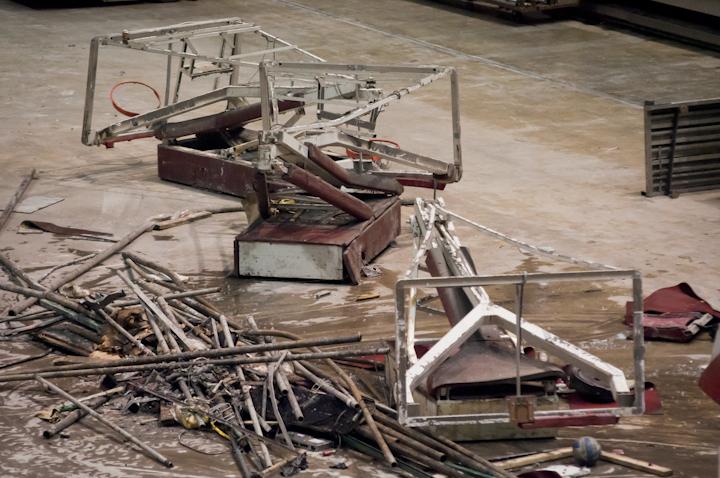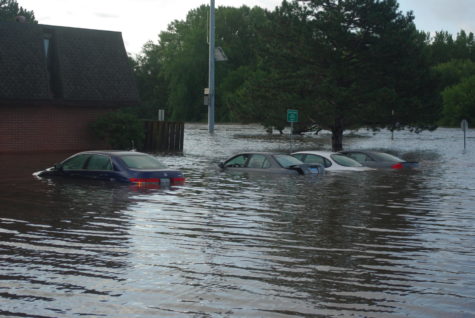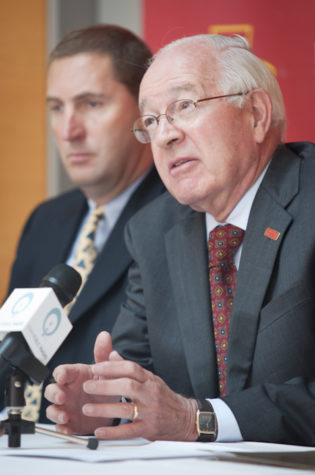University officials examine how to prevent future floods
August 22, 2010
Just 12 days ago, Ames was inundated with record amounts of floodwaters.
Now, Iowa State is beginning the recovery process.
“This recovery process is certainly going to take awhile, certainly well into the fall semester and in some areas much beyond that,” ISU President Gregory Geoffroy said in a news conference Thursday, Aug. 19.
Geoffroy spoke with Athletics Director Jamie Pollard, Vice President for Business and Finance Warren Madden, and Director of Facilities Planning and Management David Miller.
None of the officials offered estimates of financial damages or a timeline for the recovery.
Madden said the university’s next steps include discussing damage with insurance carriers and the Federal Emergency Management Agency.
“We do not have an actual estimate of the damage yet,” Madden said. “I expect next week, as we begin working with FEMA, we will be arriving at that point. It certainly is in the millions of dollars, but I’m not prepared today to give you an exact number.”
Madden said most of the damaged facilities should fall well within their insurance coverage, while buildings such as Hilton Coliseum would likely exceed their limits.
Of the buildings that were flooded, Madden said, Hilton would be the university’s first priority due to the nature of its uses. Madden and Pollard alluded to having other options to relocate the ISU soccer and volleyball teams from their damaged facilities, but not many viable options once the men’s and women’s basketball seasons begin in November.
According to a flood map released by the university Thursday, 25 buildings on campus were affected by rainfall and storms alone, and five more had standing water inside due to flooding.
Buildings damaged during storms include Durham Center, Carver Hall, Lagomarcino Hall and Kildee Hall. Miller said the two buildings most impacted were Hamilton Hall and Horticulture Hall. Miller said most of the buildings on campus were cleaned by university personnel, mostly by drying and water removal.
However, Geoffroy and Madden both said none of the damage to campus buildings will have a noticeable impact when classes begin Monday.
Going forward, no plans for future flood prevention have been discussed yet.
Max Porter, professor of civil, construction and environmental engineering, said Iowa State and the city of Ames have discussed flood prevention since the structures of the Iowa State Center were first built in the early 1970s.
He said former ISU civil engineering professor Merwin Dougal was very vocal “that the city should not be issuing building permits in the flood plain when those buildings were being built.”
Since then, a series of floods have inundated buildings in the area on four major occasions: 1975, 1993, 2008 and this year. Although the university and city have undergone changes in order to prevent flooding, including the extension of Elwood Drive — now University Boulevard — to Pammel Drive, Porter said the area requires further changes.
“To fix it right will require quite a bit of money,” he said.
He said options the university can discuss to protect the Iowa State Center include building dikes, installing flood control gates, and raising bridges and roadways. In particular, he suggested raising the bridge over Squaw Creek on Stange Road. Raising main roadways in Ames even 1 or 2 feet could help eliminate flooding, he said. He said experts will analyze the benefits of raising Interstate 35, Interstate 30, South 16th Street, South Duff Avenue, University Boulevard, Lincoln Way, Stange Road, and 13th Street.
“We do need to assess, what can we do to keep these kinds of things from happening again in the future?” Madden said. “That will involve hiring those kinds of professional consultants.”
Madden said the university thought it took significant steps toward avoiding flood damage after both major floods, in 1993 and 2008.
“Water is a very powerful force, and when it moves like it did Tuesday night into Wednesday morning, it penetrated a number of these facilities in places that had not had problems before,” Madden said.
Both Madden and Pollard mentioned the possibility of renovation to damaged facilities alongside repair and restoration.
Madden said the university was fortunate the flooding did not occur while classes were in session. However, there was an estimate that 47 students were left without homes after 27 apartments flooded in the University Village.
Those students were relocated to other apartments in the area, but some students have also been relocated to Wilson Hall, south of campus.












